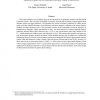ACMSE
2006
ACM
14 years 6 months ago
2006
ACM
In this paper, we describe a demonstration called an “End-to-End” demonstration developed for the 2005 offering of our grid computing course that was taught across the State o...
ACMSE
2006
ACM
14 years 6 months ago
2006
ACM
FOCS
2006
IEEE
14 years 6 months ago
2006
IEEE
A local graph partitioning algorithm finds a cut near a specified starting vertex, with a running time that depends largely on the size of the small side of the cut, rather than...
FOCS
2006
IEEE
14 years 6 months ago
2006
IEEE
We introduce a game theoretic model of network formation in an effort to understand the complex system of business relationships between various Internet entities (e.g., Autonomou...
FOCS
2006
IEEE
14 years 6 months ago
2006
IEEE
An additive spanner of an unweighted undirected graph G with distortion d is a subgraph H such that for any two vertices u, v ∈ G, we have δH(u, v) ≤ δG(u, v) + d. For every...
FOCS
2006
IEEE
14 years 6 months ago
2006
IEEE
We prove an upper bound, tight up to a factor of 2, for the number of vertices of level at most in an arrangement of n halfspaces in Rd , for arbitrary n and d (in particular, the...
FOCS
2006
IEEE
14 years 6 months ago
2006
IEEE
How much can randomness help computation? Motivated by this general question and by volume computation, one of the few instances where randomness provably helps, we analyze a noti...
FOCS
2006
IEEE
14 years 6 months ago
2006
IEEE
We convert cell-probe lower bounds for polynomial space into stronger lower bounds for near-linear space. Our technique applies to any lower bound proved through the richness meth...
FOCS
2006
IEEE
14 years 6 months ago
2006
IEEE
FOCS
2006
IEEE
14 years 6 months ago
2006
IEEE





